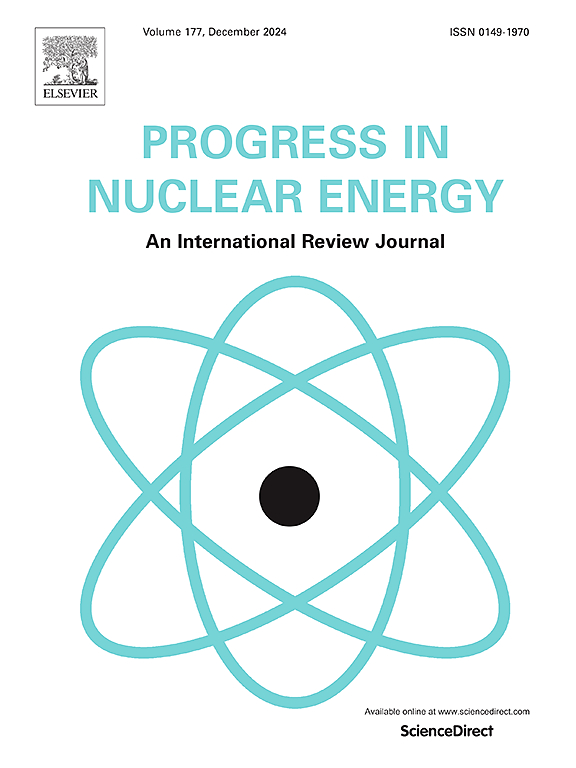Implementation of simultaneous mechanical- and chemical-spectral shift control mechanisms on the VVER-1200 assembly fueled with UO2 and MOX fuels
IF 3.2
3区 工程技术
Q1 NUCLEAR SCIENCE & TECHNOLOGY
引用次数: 0
Abstract
In the present study, simultaneous mechanical- and chemical-spectral shift control mechanisms are implemented on the VVER-1200 assembly. The chemical regulation is applied by varying the volume fraction of heavy water in mixed moderator during the burnup. The mechanical spectral shift regulation is based on the burnup-dependent change of the volumetric ratio of the moderator to fuel. It also requires modifying the structural characteristics of the reference fuel assembly. For this aim, without any change in the total fissile mass, the spectral-shift control fuel assembly (SSC-FA) is introduced by reducing both the fuel rod pitch and fuel rod numbers. This modification, in turn, increases the unit-cell numbers, where some of the unit-cells are allocated to the movable spectral shift control rods (SSCRs) filled with . To implement the suggested simultaneous mechanisms, the burnup steps of a certain length are considered, and the optimum volume fraction of heavy water and optimum insertion heights of the SSCRs in each burnup step are calculated. The implementation of the suggested methodology shows a significant improvement in both cycle burnup and conversion ratio compared to those of the reference assembly. These improvements also increase by decreasing the burnup step length. The proposed method is also applied to the equivalent MOX-fueled SSC-FA. It is observed that the use of MOX reduces the heavy water requirement and also provides slightly greater improvement in both the cycle burnup and conversion ratio compared to -fueled SSC-FA. Finally, for the considered cases, burnup-dependent variations of the fuel compositions, temperature reactivity coefficients, pin power peaking factors, and kinetics parameters are calculated and compared with each other.
在使用UO2和MOX燃料的VVER-1200组件上同时实施机械和化学光谱移位控制机制
在本研究中,在VVER-1200组件上实现了机械和化学光谱漂移同步控制机制。在燃耗过程中,通过改变H2O/D2O混合慢化剂中重水的体积分数来实现化学调节。机械光谱位移调节是基于慢化剂与燃料体积比随燃耗的变化。它还需要修改参考燃料组件的结构特性。为了实现这一目标,在不改变总裂变质量的情况下,引入了光谱移位控制燃料组件(SSC-FA),通过减少燃料棒间距和燃料棒数量。这种修改反过来又增加了单元格的数量,其中一些单元格被分配给充满ThO2的可移动谱移控制棒(sscr)。为了实现所建议的同步机制,考虑了一定长度的燃燃步骤,并计算了每个燃燃步骤中sscr的最佳重水体积分数和最佳插入高度。与参考组件相比,建议的方法的实施在循环燃耗和转化率方面都有显着改善。这些改进还通过减少燃耗步长而增加。该方法也适用于等效mox燃料的SSC-FA。可以观察到,与uo2燃料的SSC-FA相比,MOX的使用减少了重水需求,并且在循环燃耗和转化率方面也有了略大的改善。最后,对于所考虑的情况,计算了燃料成分、温度反应性系数、引脚功率峰值因子和动力学参数的燃烧依赖变化并相互比较。
本文章由计算机程序翻译,如有差异,请以英文原文为准。
求助全文
约1分钟内获得全文
求助全文
来源期刊

Progress in Nuclear Energy
工程技术-核科学技术
CiteScore
5.30
自引率
14.80%
发文量
331
审稿时长
3.5 months
期刊介绍:
Progress in Nuclear Energy is an international review journal covering all aspects of nuclear science and engineering. In keeping with the maturity of nuclear power, articles on safety, siting and environmental problems are encouraged, as are those associated with economics and fuel management. However, basic physics and engineering will remain an important aspect of the editorial policy. Articles published are either of a review nature or present new material in more depth. They are aimed at researchers and technically-oriented managers working in the nuclear energy field.
Please note the following:
1) PNE seeks high quality research papers which are medium to long in length. Short research papers should be submitted to the journal Annals in Nuclear Energy.
2) PNE reserves the right to reject papers which are based solely on routine application of computer codes used to produce reactor designs or explain existing reactor phenomena. Such papers, although worthy, are best left as laboratory reports whereas Progress in Nuclear Energy seeks papers of originality, which are archival in nature, in the fields of mathematical and experimental nuclear technology, including fission, fusion (blanket physics, radiation damage), safety, materials aspects, economics, etc.
3) Review papers, which may occasionally be invited, are particularly sought by the journal in these fields.
 求助内容:
求助内容: 应助结果提醒方式:
应助结果提醒方式:


